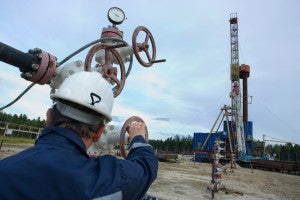Strong New Methane Standards Would Stop Waste, Save Money (and Also Protect the Climate)

If you send a bucket to the well, you make sure it doesn’t have a hole in it first. You’re careful that the new milk carton isn’t seeping all over your refrigerator shelf. And you know that a dripping water pipe can mean big problems if you don’t get after it quickly. Leaks are messy, wasteful, and often costly.
That’s why sensible people avoid leaks when they can, and fix them when they need to.
And it’s why oil and gas companies should be fixing thousands of leaks that are letting at least $1.7 billion dollars’ worth of natural gas vent or leak from their well sites, pipelines, and local gas delivery systems every year. The waste is enough natural gas to heat five million homes a year.
It’s bad enough to waste a valuable commodity. What’s worse is that unburned natural gas, which is mostly methane, has a potent effect on the climate, packing over 80 times more warming power than carbon dioxide over the first twenty years of a methane molecule in the atmosphere. And that leaking methane is frequently accompanied by smog-forming pollution.
The good news is that substantially reducing methane venting and leaks is straightforward and inexpensive, using basic technologies and operating practices that are readily available. Even better, tackling methane emissions creates high-quality manufacturing and service jobs. As a recent report commissioned by EDF shows, 76 companies in 46 states are already providing the services and technologies needed to manufacture, sell, and support the proven methane control technologies needed to tackle this problem.
There are some companies in the oil and gas industry that have already taken steps to reduce methane venting and waste. But with thousands of producers around the country, only consistent national rules can ensure that companies have a level playing field and people have the protection they deserve.
As a result, EDF and others have been calling for strong, sensible federal standards requiring companies to substantially reduce venting and leaks of methane. Last spring, the Obama Administration announced its intention to implement an integrated methane emission reduction strategy with regulation of oil and gas emissions at its core. We expect an announcement very shortly from the Environmental Protection Agency (EPA) on how it plans to address methane pollution from both new and existing oil and gas operations.
A new report this week from the Clean Air Task Force (CATF) reinforces earlier findings: Significant cuts in methane emissions from the oil and gas industry are both feasible and cost-effective using today’s technology. Building on evidence from an ICF International report commissioned by EDF earlier this year, CATF concludes we can cut methane emissions from oil and gas operations in half, saving enough natural gas to heat almost 2.5 million homes.
With fall rapidly winding down and the EPA deadline approaching, the push for strong federal regulation of methane emissions from the oil and gas industry continues. Starting this week, EDF is running ads on buses circulating through the nation’s capital, reminding decision makers that it’s just plain common sense to fix the holes. The message: EPA needs to act now to “Create jobs. Save energy. Reduce pollution.”
The clock is ticking, and for our climate, health, and economy, there’s no time – or energy – to waste.
Add your voice asking the EPA to take action and reduce methane emissions.











